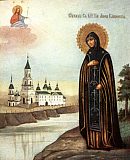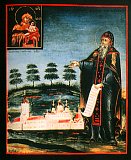

| Previous day | Next day |
| Old Style
June 12
|
Sunday |
New Style
June 25
|
|
3rd Sunday after Pentecost.
Tone 2.
Fast of the Holy Apostles. |
Fish, wine and oil allowed.
|
![]() St. Onuphrius the Great (4th c.).
St. Onuphrius the Great (4th c.). ![]() St. Peter of Mt. Athos (734).
St. Peter of Mt. Athos (734).
Sts. John, Andrew, Heraclemon, and Theophilus, hermits, of Egypt (4th c.). St. Arsenius, founder of Konevits Monastery (1447). St. Onuphrius, founder of Malsk Monastery (Pskov) (1492). Sts. Onuphrius and Auxentius, monks, of Vologda (15th c.-16th c). Sts. Jonah and Bassian, monks, of Pertoma (Solovki) (1561). St. Stephen of Komel, founder of Ozersk Monastery (Vologda) (1542). First (1650) and second (1909) glorifications of St. Anna, princess of Kashin (Euphrosyne in monasticism). St. Onuphrius, founder of Katrom Monastery (Vologda) (16th c). Uncovering of the relics of St. John of Moscow, fool-for-Christ (1672).
Miracle-working icons of the Theotokos and St. Onuphrius at St. Onuphrius Monastery (Poland).
St. Amphianus, bishop and confessor, in Cilicia (ca. 310). St. Olympius, bishop and confessor, in Thrace (4th c.). St. Timothy the Hermit, of Egypt (4th c.). Virgin-martyr Cunera of Rhenen (Neth.) (451). St. Julian of the Dagouta Church in Constantinople. St. John the Soldier, of Egypt (6th c.-7th c.). St. John (Tornicus) of Mt. Athos and Georgia (998). Synaxis of the Saints of St. Onuphrius Monastery at Jablechna (Poland). St. Triphyllius, bishop of Leucosia [Nicosia] on Cyprus (370).
Repose of Elder Peter of Katounakia, Mt. Athos (1867), and Blessed Hermit Philaretus of Mt. Athos (1961).
Thoughts for Each Day of the Year
According to the Daily Church Readings from the Word of God
By St. Theophan the Recluse

Third Sunday After Pentacost. [Rom. 5:1-10; Matt. 6:22-33]
If therefore thine eye be single[1] thy whole body shall be full of light. But if thine eye be evil, thy whole body shall be full of darkness. Here the mind is called the eye, and the entire composition of the soul is called the body. Thus, when the mind is simple then it is light in the soul; when the mind is evil, then it is dark in the soul. What are a simple mind and an evil mind? A simple mind is one which accepts the word of God as is written, and is convinced beyond a doubt that all is indeed as is written. It has no deceit, no wavering, or hesitation. An evil mind is one which approaches the word of God with slyness, artful disputing, and questioning. It cannot directly believe, but subjects the word of God to its sophistry. It approaches the word not as a disciple, but as a judge and critic, to test something stated there, and then either scoffs at it, or says in a haughty manner, “Yes, not bad.” Such a mind has no firm tenets, because it clearly does not believe the word of God, and its own rationale is always unstable—today one way, tomorrow another. It has only wavering, confusion, questions without answers; everything is out of place with it, and it walks in the dark, fumbling its way. A simple mind sees everything clearly: every thing in it has a definite character, determined by the word of God. That is why every thing in it has its place, and it knows exactly how to behave with relation to things—it walks along open, visible roads, with complete assurance that they lead to the true goal.
[1] In Church Slavonic, the text translates as, If thine eye be pure.








